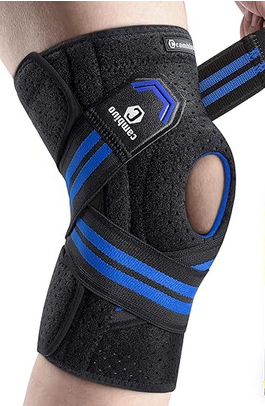People with knee issues often ask themselves When to wear a knee sleeve? Knee sleeves are valuable tools for joint support and pain relief, but knowing when to wear them is crucial for maximizing their benefits. This guide will help you understand the appropriate times to use knee sleeves, whether you’re an athlete, fitness enthusiast, or someone managing knee discomfort.
When to Wear Knee Sleeves: General Guidelines
Knee sleeves can be beneficial in various situations and sometimes it is just life taking its toll.
- During exercise: or after excercise, particularly for activities like walking or running or biking that put stress on your knees.
- For knee pain relief: When experiencing mild to moderate knee discomfort.
- For joint support: To provide stability during daily activities or sports.
- Post-injury recovery: Under a doctor’s guidance, to aid in rehabilitation.
- Arthritis management: To alleviate symptoms and improve mobility.
It’s important to note that knee sleeves are different from knee braces. While braces limit motion and are typically used for serious injuries, compression sleeves offer support and can help with minor knee problems.
Specific Scenarios for Wearing Knee Sleeves

When to wear Knee Sleeves for Weightlifting and Squats?
When engaging in weightlifting or performing squats, knee sleeves can be particularly beneficial:
- Increased stability: Knee sleeves provide compression that can enhance your proprioception, improving your awareness of knee position during lifts.
- Warmth retention: The compression helps keep your knee joint warm, potentially reducing the risk of injury.
- Support for heavy lifts: During squats or deadlifts, knee sleeves can offer additional support to your knee joint.
When to Wear a Knee Sleeve for CrossFit?
CrossFit workouts often involve high-intensity, varied movements that can put stress on your knees. Wearing knee sleeves during CrossFit can be helpful for:
- Injury prevention: The added support may help reduce the risk of knee injuries during dynamic movements.
- Performance enhancement: By improving blood flow and reducing pain, knee sleeves might help you perform better during workouts.
- Recovery: The compression can aid in reducing swelling post-workout, potentially speeding up recovery.
Running and High-Impact Activities
Runners and those engaging in high-impact activities may benefit from knee sleeves:
- Shock absorption: Knee sleeves can help absorb some of the impact, reducing stress on the knee joint.
- Patellar tracking: Some knee sleeves are designed to help keep the kneecap in proper alignment during repetitive motions.
- Reduced fatigue: The compression may help delay muscle fatigue in the quadriceps and surrounding muscles.
Know you know when to wear a knee sleeve, so know we will answer when not to wear a knee sleeve.

When Not to Wear Knee Sleeves
While knee sleeves can be beneficial, there are times when you should avoid using them:
- All day, every day: Knee sleeves are not designed for constant wear. Only use them during activities that require extra support.
- Without medical advice: If you have a diagnosed knee injury or are recovering from surgery, consult your doctor before using a knee sleeve.
- Over open wounds: If you have cuts or abrasions on your knee, wait until they heal before using a sleeve.
- If they cause discomfort: If a knee sleeve causes pain or restricts your range of motion, stop using it and consult a healthcare professional.
Choosing the Right Knee Sleeve
When selecting a knee sleeve, consider the following factors:
- Fit: Measure your knee circumference and refer to the manufacturer’s size chart for the best fit.
- Material: Look for breathable, moisture-wicking fabrics to reduce odor and skin irritation.
- Purpose: Some sleeves are designed for specific activities or levels of support.
- Quality: Invest in a durable sleeve that can withstand your activity level.
Additional Knee Care Tips
Wearing a knee sleeve is just one aspect of knee care. Consider these additional measures:
- Strength training: Focus on exercises that strengthen the muscles supporting your knees.
- Flexibility: Maintain good flexibility in your leg muscles to reduce stress on your knees.
- Proper form: Ensure you’re using correct technique during exercises to avoid unnecessary knee strain.
- Rest and recovery: Allow adequate time for your knees to recover between intense workouts.
- Low-impact alternatives: Consider incorporating activities like cycling or swimming to reduce knee stress.
Remember, while knee sleeves can provide support and relief, they are not a cure-all for knee problems. If you experience persistent knee pain or swelling, consult a healthcare professional for a proper diagnosis and treatment plan.
By understanding when and how to use knee sleeves effectively, you can enhance your performance, reduce discomfort, and potentially lower your risk of knee injuries during various activities.

